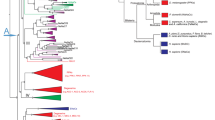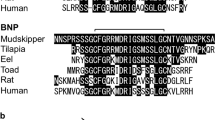Abstract
Lampreys are one of the most primitive vertebrates still living today. They attach themselves to the body surface of the host fish through their sucker-like mouths and suck blood of the host for days. Recent fossil evidence has indicated that morphology of lampreys in the late Devonian period, over 360 million years ago, already possessed the present day major characteristics, suggesting the evolutionary stability of a highly specialized parasitic feeding habit. Obviously, nociceptive responses and hemostasis of the host are two major barriers to long-term feeding of the parasitic lamprey. It has been found, to counteract hemostasis of the host, that paired buccal glands of lampreys secrete antihemostatic compounds to prevent blood of the host from coagulation. However, it is not known how lampreys make the host lose nociceptive responses. Here, we prepared components of the crude extract from the buccal glands of the lampreys (Lampetra japonica). Then, we show that crude extract and one of its purified components reduce the firing frequency of neuronal action potentials probably through inhibiting the voltage-dependent Na+ channels. As the voltage-gated Na+ channels are highly conserved throughout evolution, we argue that the secretion of the lampreys could exert the similar effect on the Na+ channels of their host fish as well. Therefore, together with its antihemostatic effect, the secretion due to its inhibitory effect on neuronal excitability might provide a mechanism for the parasitic lampreys to keep their evolutionary stability.






Similar content being viewed by others
Abbreviations
- AP:
-
Action potential
- BGSP-1:
-
Buccal gland secretion protein-1
- CRISP:
-
Cysteine-rich secretory proteins
- CRBGP:
-
Cysteine-rich buccal gland protein
- DRG:
-
Dorsal root ganglion
- L. japonica :
-
Lampetra japonica
- SDS-PAGE:
-
Sodium dodecyl sulfate-polyacrylamide gel
- TTX-R:
-
Tetrodotoxin-resistant
- TTX-S:
-
Tetrodotoxin-sensitive
References
Akopian AN, Sivilotti L, Wood JN (1996) A tetrodotoxin-resistant voltage-gated sodium channel expressed by sensory neurons. Nature 379:257–262
Ashley PJ, Sneddon LU, McCrohan CR (2007) Nociception in fish: stimulus-response properties of receptors on the head of trout Oncorhynchus mykiss. Brain Res 1166:47–54
Baxter EW (1956) Observations on the buccal glands of lampreys (petromyzonidae). Proc Zool Soc Lond 127:95–118
Catterall WA, Goldin AL, Waxman SG (2005) Nomenclature and structure–function relationships of voltage-gated sodium channels. Pharmacol Rev 57:397–409
Chen X, Chi S, Liu M, Yang W, Wei T, Qi Z, Yang F (2005) Inhibitory effect of ganglioside GD1b on K+ current in hippocampal neurons and its involvement in apoptosis suppression. J Lipid Res 46:2580–2585
Chopra SS, Watanabe H, Zhong TP, Roden DM (2007) Molecular cloning and analysis of zebrafish voltage-gated sodium channel beta subunit genes: implications for the evolution of electrical signaling in vertebrates. BMC Evol Biol 7:113
Coste B, Crest M, Delmas P (2007) Pharmacological dissection and distribution of NaN/Nav1.9, T-type Ca2+ currents, and mechanically activated cation currents in different populations of DRG neurons. J Gen Physiol 129:57–77
Dan A, Pereira MH, Pesquero JL, Diotaiuti L, Beirao PS (1999) Action of the saliva of Triatoma infestans (Heteroptera: Reduviidae) on sodium channels. J Med Ent 36:875–879
DiGregorio DA, Peskoff A, Vergara JL (1999) Measurement of action potential-induced presynaptic calcium domains at a cultured neuromuscular junction. J Neurosci 19:7846–7859
Dunlop R, Laming P (2005) Mechanoreceptive and nociceptive responses in the central nervous system of goldfish (Carassius auratus) and trout (Oncorhynchus mykiss). J Pain 6:561–568
Farmer GJ (1980) Biology and physiology of feeding in adult lampreys. Can J Fish Aquat Sci 37:1751–1761
Forey P, Janvier P (1993) Agnathans and the origin of jawed vertebrates. Nature 361:129–134
Gage SH, Gage MG (1927) The anticoagulant action of the secretion of the buccal glands of the lampreys (Petromyzon, Lampetra and Enlosphenun). Science 66:282
Gess RW, Coates MI, Rubidge BS (2006) A lamprey from the Devonian period of South Africa. Nature 443:981–984
Goldin AL (2002) Evolution of voltage-gated Na+ channels. J Exp Biol 205:575–584
Guo M, Teng M, Niu L, Liu Q, Huang Q, Hao Q (2005) Crystal structure of the cysteine-rich secretory protein stecrisp reveals that the cysteine-rich domain has a K+ channel inhibitor-like fold. J Biol Chem 280:12405–12412
Heavner JE (2007) Local anesthetics. Curr Opin Anaesthesiol 20:336–342
Hille B (2001) Ion channel of excitable membranes. Sinauer, Sunderland, MA
Ito N, Mita M, Takahashi Y, Matsushima A, Watanabe YG, Hirano S, Odani S (2007) Novel cysteine-rich secretory protein in the buccal gland secretion of the parasitic lamprey, Lethenteron japonicum. Biochem Biophys Res Commun 358:35–40
Janvier P (2006) Palaeontology: modern look for ancient lamprey. Nature 443:921–924
Laemmli UK (1970) Cleavage of structural proteins during the assembly of the head of bacteriophage T4. Nature 227:680–685
Lennon RE (1954) Feeding mechanism of the sea lamprey and its effect on host fishes. Fish Bull US Dep Interior 98:247–293
Liu L, Yang T, Bruno MJ, Andersen OS, Simon SA (2004) Voltage-gated ion channels in nociceptors: modulation by cGMP. J Neurophysiol 92:2323–2332
Lopreato GF, Lu Y, Southwell A, Atkinson NS, Hillis DM, Wilcox TP, Zakon HH (2001) Evolution and divergence of sodium channel genes in vertebrates. Proc Natl Acad Sci USA 98:7588–7592
Melnick IV, Santos SF, Safronov BV (2004) Mechanism of spike frequency adaptation in substantia gelatinosa neurons of rat. J Physio 559:383–395
Morrissette J, Krätzschmar J, Haendler B, El-Hayek R, Mochca-Morales J, Martin BM, Patel JR, Moss RL, Schleuning WD, Coronado R, Possani LD (1995) Primary structure and properties of helothermine, a peptide toxin that blocks ryanodine receptors. Biophys J 68:2280–2288
Novak AE, Jost MC, Lu Y, Taylor AD, Zakon HH, Ribera AB (2006) Gene duplications and evolution of vertebrate voltage-gated sodium channels. J Mol Evol 63:208–221
Olschewski A, Hempelmann G, Vogel W, Safronov BV (2001) Suppression of potassium conductance by droperidol has influence on excitability of spinal sensory neurons. Anesthesiology 94:280–289
Ribeiro JM, Francischetti IM (2003) Role of arthropod saliva in blood feeding: sialome and post-sialome perspectives. Annu Rev Entomol 48:73–88
Rovainen CM (1996) Feeding and breathing in lampreys. Brain Behav Evol 48:297–305
Roy ML, Narahashi T (1992) Differential properties of tetrodotoxin-sensitive and tetrodotoxin-resistant sodium channels in rat dorsal root ganglion neurons. J Neurosci 12:2104–2111
Schreiber MC, Karlo JC, Kovalick GE (1997) A novel cDNA from Drosophila encoding a protein with similarity to mammalian cysteine-rich secretory proteins, wasp venom antigen 5, and plant group 1 pathogenesis-related proteins. Gene 191:135–141
Shikamoto Y, Suto K, Yamazaki Y, Morita T, Mizuno H (2005) Crystal structure of a CRISP family Ca2+-channel blocker derived from snake venom. J Mol Biol 350:735–743
Sneddon LU, Braithwaite VA, Gentle MJ (2003) Do fishes have nociceptors? Evidence for the evolution of a vertebrate sensory system. Proc Biol Sci 270:1115–1121
Spafford JD, Spencer AN, Gallin WJ (1999) Genomic organization of a voltage-gated Na+ channel in a hydrozoan jellyfish: insights into the evolution of voltage-gated Na+ channel genes. Receptors Channels 6:493–506
Wang F, Li H, Liu MN, Song H, Han HM, Wang QL, Yin CC, Zhou YC, Qi Z, Shu YY, Lin ZJ, Jiang T (2006) Structural and functional analysis of natrin, a venom protein that targets various ion channels. Biochem Biophys Res Commun 351:443–448
Wang J, Shen B, Guo M, Lou X, Duan Y, Cheng XP, Teng M, Niu L, Liu Q, Huang Q, Hao Q (2005) Blocking effect and crystal structure of natrin toxin, a cysteine-rich secretory protein from Naja atra venom that targets the BKCa channel. Biochemistry 44:10145–10152
Xiao R, Li QW, Perrett S, He RQ (2007) Characterisation of the fibrinogenolytic properties of the buccal gland secretion from Lampetra japonica. Biochimie 89:383–392
Zimmermann K, Leffler A, Babes A, Cendan CM, Carr RW, Kobayashi J, Nau C, Wood JN, Reeh PW (2007) Sensory neuron sodium channel Nav1.8 is essential for pain at low temperatures. Nature 447:855–858
Acknowledgments
This work was supported by grants from the National Basic Research Program of China (2005CB522804, 2006CB911003, 2006CB500703).
Author information
Authors and Affiliations
Corresponding authors
Additional information
Shaopeng Chi, Rong Xiao, and Qingwei Li contributed equally to this work.
Electronic supplementary material
Rights and permissions
About this article
Cite this article
Chi, S., Xiao, R., Li, Q. et al. Suppression of neuronal excitability by the secretion of the lamprey (Lampetra japonica) provides a mechanism for its evolutionary stability. Pflugers Arch - Eur J Physiol 458, 537–545 (2009). https://doi.org/10.1007/s00424-008-0631-1
Received:
Revised:
Accepted:
Published:
Issue Date:
DOI: https://doi.org/10.1007/s00424-008-0631-1




